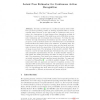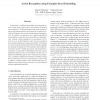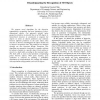76 search results - page 6 / 16 » Modeling and recognition of actions through motor primitives |
PERCOM
2003
ACM
14 years 1 months ago
2003
ACM
Seeking to extend the functional capability of the elderly, we explore the use of probabilistic methods to learn and recognise human activity in order to provide monitoring suppor...
ECCV
2008
Springer
14 years 10 months ago
2008
Springer
Recently, models based on conditional random fields (CRF) have produced promising results on labeling sequential data in several scientific fields. However, in the vision task of c...
CVPR
2008
IEEE
14 years 10 months ago
2008
IEEE
In this paper, we address the problem of representing human actions using visual cues for the purpose of learning and recognition. Traditional approaches model actions as space-ti...
CVPR
2009
IEEE
14 years 3 months ago
2009
IEEE
We propose novel algorithms for the detection, segmentation, recognition, and pose estimation of threedimensional objects. Our approach initially infers geometric primitives to de...
NN
1998
Springer
13 years 8 months ago
1998
Springer
Visual information is processed in the posterior parietal cortex for the hypothesized purpose of extracting a variety of affordances for the generation of motor behavior. The term...



